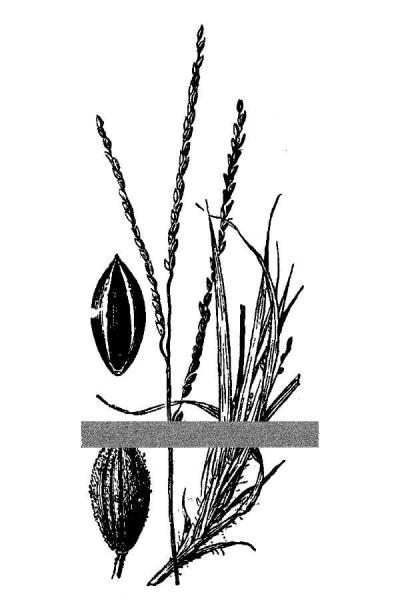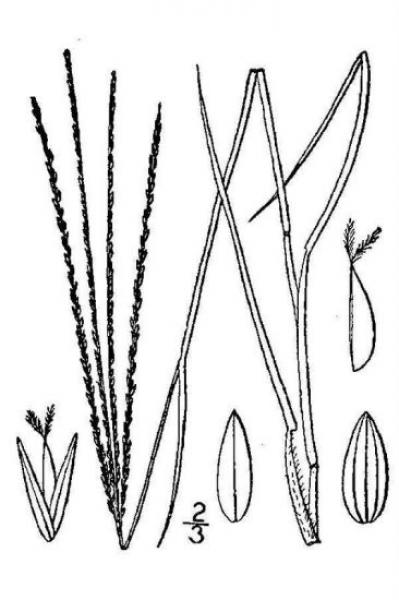Slender Crab Grass
Digitaria filiformis (L.) Koel.
- Class
- Monocotyledoneae (Monocots)
- Family
- Poaceae (Grass Family)
- State Protection
- Endangered
Listed as Endangered by New York State: in imminent danger of extirpation in New York. For animals, taking, importation, transportation, or possession is prohibited, except under license or permit. For plants, removal or damage without the consent of the landowner is prohibited.
- Federal Protection
- Not Listed
- State Conservation Status Rank
- S1
Critically Imperiled in New York - Especially vulnerable to disappearing from New York due to extreme rarity or other factors; typically 5 or fewer populations or locations in New York, very few individuals, very restricted range, very few remaining acres (or miles of stream), and/or very steep declines.
- Global Conservation Status Rank
- G5
Secure globally - Common in the world; widespread and abundant (but may be rare in some parts of its range).
Summary
Did you know?
The name for the genus comes from the Latin for finger and refers to the fingerlike flowering stalks of the genus (Fernald 1950). Even though some species of crabgrass are known for their weediness in lawns, Digitaria filiformis is not weedy even though it can occur in habitats preferred by weeds, like roadsides and open sandy areas. It may often be overlooked because it is small and delicate.
State Ranking Justification
There are 5 existing populations, but only one population has over 100 plants. There are 30 historical occurrences, but almost all very old records are from western Long Island and New York City and are considered extirpated.
Short-term Trends
There is not enough recent information to understand short-term trends.
Long-term Trends
There has been a very large decline in numbers over the last 100 years, as most of the open habitat of this species was developed. There seems to be plenty of habitat left on eastern Long Island, but numbers are still low so the long-term trend is not encouraging.
Conservation and Management
Threats
Since many of these populations occur within small natural areas or human-disturbed areas, they are threatened by direct development, indirect consequences of development such as increased human use of trails and dumping, and by invasive species.
Conservation Strategies and Management Practices
This species needs disturbance to reduce competition, but too much direct disturbance to the plants will reduce the population. Its habitat could be disturbed in the non-growing season to open it up for seed germination and colonization, but direct disturbance should be prevented during the growing season.
Research Needs
Research on habitat preference is needed because it seems to grow in disturbed habitats that are very common on Long Island but it is only in a very small portion of this habitat.
Habitat
Habitat
In New York, Digitaria filiformis occupies sandy, open, often disturbed habitats near the coast. These include dunes, sandy roadsides and fencerows, the edges of brackish meadows and salt marshes, and openings within pine barrens and oak woodlands (New York Natural Heritage Program 2011). Fields and open ground (Gleason and Cronquist 1991). Sterile or sandy soil (Fernald 1970).
Associated Ecological Communities
- Mowed roadside/pathway*
A narrow strip of mowed vegetation along the side of a road, or a mowed pathway through taller vegetation (e.g., meadows, old fields, woodlands, forests), or along utility right-of-way corridors (e.g., power lines, telephone lines, gas pipelines). The vegetation in these mowed strips and paths may be dominated by grasses, sedges, and rushes; or it may be dominated by forbs, vines, and low shrubs that can tolerate infrequent mowing.
- Pitch pine-heath barrens*
(guide)
A shrub-savanna community that occurs on well-drained, sandy or rocky soils. The most abundant tree is pitch pine and the shrublayer is dominated by heath shrubs.
- Pitch pine-oak forest*
(guide)
A mixed forest that typically occurs on well-drained, sandy soils of glacial outwash plains or moraines; it also occurs on thin, rocky soils of ridgetops. The dominant trees are pitch pine mixed with one or more of the following oaks: scarlet oak, white oak, red oak, or black oak.
* probable association but not confirmed.
Associated Species
- Acer rubrum
- Bulbostylis capillaris (tufted hair sedge)
- Clethra alnifolia (coastal sweet-pepperbush)
- Nyssa sylvatica (black-gum, sour-gum)
- Pinus rigida (pitch pine)
- Schizachyrium scoparium
Range
New York State Distribution
This grass is currently known from Suffolk County, but was historically known west through New York City, north to Ulster County, with a disjunct location in Yates County. There are also unsubstantiated reports from Dutchess and Albany counties.
Global Distribution
This grass is most common from southeastern Pennsylvania, west to Illinois and Eastern Kansas, then south to East Texas. It reaches its northeastern limits in southeastern New York north to New Hampshire, where it may be extirpated. It also extends south into Mexico.
Identification Comments
General Description
Digitaria filiformis is a grass with branching stems up to 150 centimeters long, sometimes rooting at the lower nodes The leaves are 2-6 millimeters wide, the lower leaf sheaths with soft hairs. The stems bear 2-6 erect or ascending racemes, each with a slender, 3-angled rachis, and spikelets borne in groups of 2 to 5. The spikelets are 1.3 to 2.8 millimeters long, with the first glume absent, and the second glume and sterile lemma are usually pubescent with gland-tipped hairs. (FNA 2003).
Best Life Stage for Proper Identification
The entire plant with flowers, or preferably fruit, is needed for identification.
Similar Species
All of the other species of Digitaria found in New York have racemes with relatively wider (0.5 to 1 millimeter wide), winged rachises compared to the slender (less than 0.5 millimeters wide), wingless rachises of D. filiformis.
Best Time to See
This species flowers in August and fruits may persist through October.
- Fruiting
The time of year you would expect to find Slender Crab Grass fruiting in New York.
Slender Crab Grass Images
Taxonomy
Slender Crab Grass
Digitaria filiformis (L.) Koel.
- Kingdom Plantae
- Phylum Anthophyta
- Class Monocotyledoneae
(Monocots)
- Order Cyperales
- Family Poaceae (Grass Family)
- Order Cyperales
- Class Monocotyledoneae
(Monocots)
- Phylum Anthophyta
Synonyms
- Syntherisma filiformis (L.) Nash
Additional Resources
Best Identification Reference
Flora of North America Editorial Committee. 2003. Flora of North America, North of Mexico. Volume 25. Magnoliophyta: Commelinidae (in part): Poaceae, part 2. Oxford University Press, New York. 783 pp.
Other References
Fernald, M.L. 1950. Gray's manual of botany. 8th edition. D. Van Nostrand, New York. 1632 pp.
Gleason, Henry A. and A. Cronquist. 1991. Manual of Vascular Plants of Northeastern United States and Adjacent Canada. The New York Botanical Garden, Bronx, New York. 910 pp.
Holmgren, Noel. 1998. The Illustrated Companion to Gleason and Cronquist's Manual. Illustrations of the Vascular Plants of Northeastern United States and Adjacent Canada. The New York Botanical Garden, Bronx, New York.
Mitchell, Richard S. and Gordon C. Tucker. 1997. Revised Checklist of New York State Plants. Contributions to a Flora of New York State. Checklist IV. Bulletin No. 490. New York State Museum. Albany, NY. 400 pp.
New York Natural Heritage Program. 2010. Biotics database. New York Natural Heritage Program. New York State Department of Environmental Conservation. Albany, NY.
New York Natural Heritage Program. 2024. New York Natural Heritage Program Databases. Albany, NY.
Weldy, T. and D. Werier. 2010. New York flora atlas. [S.M. Landry, K.N. Campbell, and L.D. Mabe (original application development), Florida Center for Community Design and Research http://www.fccdr.usf.edu/. University of South Florida http://www.usf.edu/]. New York Flora Association http://newyork.plantatlas.usf.edu/, Albany, New York
Links
About This Guide
Information for this guide was last updated on: February 25, 2011
Please cite this page as:
New York Natural Heritage Program. 2024.
Online Conservation Guide for
Digitaria filiformis.
Available from: https://guides.nynhp.org/slender-crab-grass/.
Accessed July 26, 2024.

